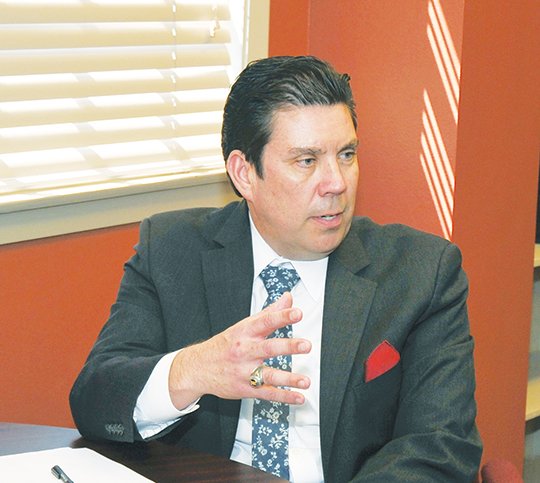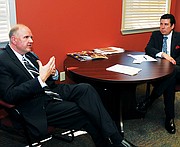Every Hot Springs police officer and civilian employee will undergo training beginning today in a "relatively new concept" of procedural justice that emphasizes better communication and relationships with the community in the future.
Lt. Andy Harvey, a 20-year veteran of the Dallas Police Department who currently serves on the DPD command staff and previously as public information officer, is considered one of the top experts on procedural justice, and has taught it as a training program for three years.
"This is a relatively new concept in justice that is very timely and relevant today in working on and establishing a better rapport with the community," Hot Springs Interim Police Chief Jason Stachey said Tuesday.
The classes will be held from 8 a.m. to noon and 1-5 p.m. today through Friday, with every uniformed officer, civilian employee and all the employees of Hot Springs Animal Control, who fall under the supervision of the HSPD, required to attend one of the sessions.
"Once I really understood the positive attributes of this concept I wanted every employee to undergo the training," Stachey said. "It stresses the importance of community and public perception of the police department. How we as civil servants address members of the entire community and provide customer service."
Harvey said he researched procedural justice and made it the focus of his white paper during graduate school at Leadership Command College at the Law Enforcement Management Institute of Texas at Sam Houston State University.
Last year, the President's Task Force on 21st Century Policing included procedural justice as a major part of their findings. "I was very proud of that," he said. "That's when I knew for sure I was on to something."
Harvey said one of the basic components of the concept is that "people want to be treated with dignity and respect. They usually care about that more than the actual outcome of the situation. Every encounter between the public and the police matters and the way they are treated throughout the encounter."
He said the idea is to get away from being focused on just the outcome and focusing on making sure the citizen is satisfied with the encounter.
"A lot of it is just listening. Giving them a voice. Letting them tell their side of the story. Showing compassion and understanding," Harvey said. "It's really a basic common-sense approach. People want to know we get it and understand them. Then they feel more satisfied with the service they are getting."
He said what happens a lot of times is that the supervisor will get a call from a citizen with a complaint. "It's usually a rudeness complaint. That is the No. 1 problem across the board. And a lot of that is failure to manage the perception."
He said what happens is the police chief or supervisor has "to paint the picture so the citizen can understand what is happening," such as the procedures and reasoning involved. "It's just a matter of making the citizen feel like they were treated fairly."
He said with the training the idea is for the officer "to take that same concept to use in the field and cut out the need for the second encounter. Avoid that situation. He just has to take a few seconds to explain what is happening."
Harvey said by increasing the public's level of satisfaction, you also increase officer safety. "You're not having to lay your hands on people as often. You avoid conflict and you have less people, officers and citizens, getting hurt."
He said it also reduces stress in the officer's life. "Officers are already under a lot of stress day to day. That's not good for them or their families."
Another positive benefit is that procedural justice can actually have an impact on crime. "You have more people willing to cooperate with the police and give us information. More working with us and supporting the police," he said.
"Any detective will tell you the fastest and best way to clear a case is for someone to come forward and give information. More cooperation benefits everyone."
Harvey said most conflicts arise from the public "not understanding what we do or why we do it. You have two different perspectives on any situation and it goes back to simply explaining your actions."
If a citizen questions why police are working traffic on a particular corner, "You explain that there have been a lot of accidents there or because this happened or that happened. Some officers fail to communicate that."
Stachey said, "As far as I know, I'm not for certain, but I believe we are the only police department in Arkansas to provide this training, certainly for the entire department. As I said, it's still a relatively new concept."
Stachey said he was undergoing training at Sam Houston several years ago and heard Harvey speak on the concept and "became an advocate of it. I researched it. I think in today's environment it's very important for the entire law enforcement community, across the entire United States, to start doing this."
Stachey said earlier Tuesday Harvey spoke to the Arkansas Association of Chiefs of Police for the Southwest Region, explaining the concept to about 20 chiefs in attendance and "got a lot of positive feedback and interest from all of them."
HSPD Capt. Walt Everton said, "(Harvey) did a really good job of taking this four-hour course and breaking it down" into a one hour talk. "It was impressive," he said.
"Today's policing is challenging," Harvey said. "More today than ever and police departments are historically resistant to change." He said the course he teaches breaks the concept down into a three phase model to follow for every encounter: Initial contact, the process in the middle and the outcome.
"It gives them a visual of what they should do every day. Every encounter is a commercial. A chance to promote your department. Every encounter is an opportunity to improve communication and to influence their perception of the police department.
"These are not major changes. It's just a click to the right. Doing it a little different."
Local on 03/30/2016

